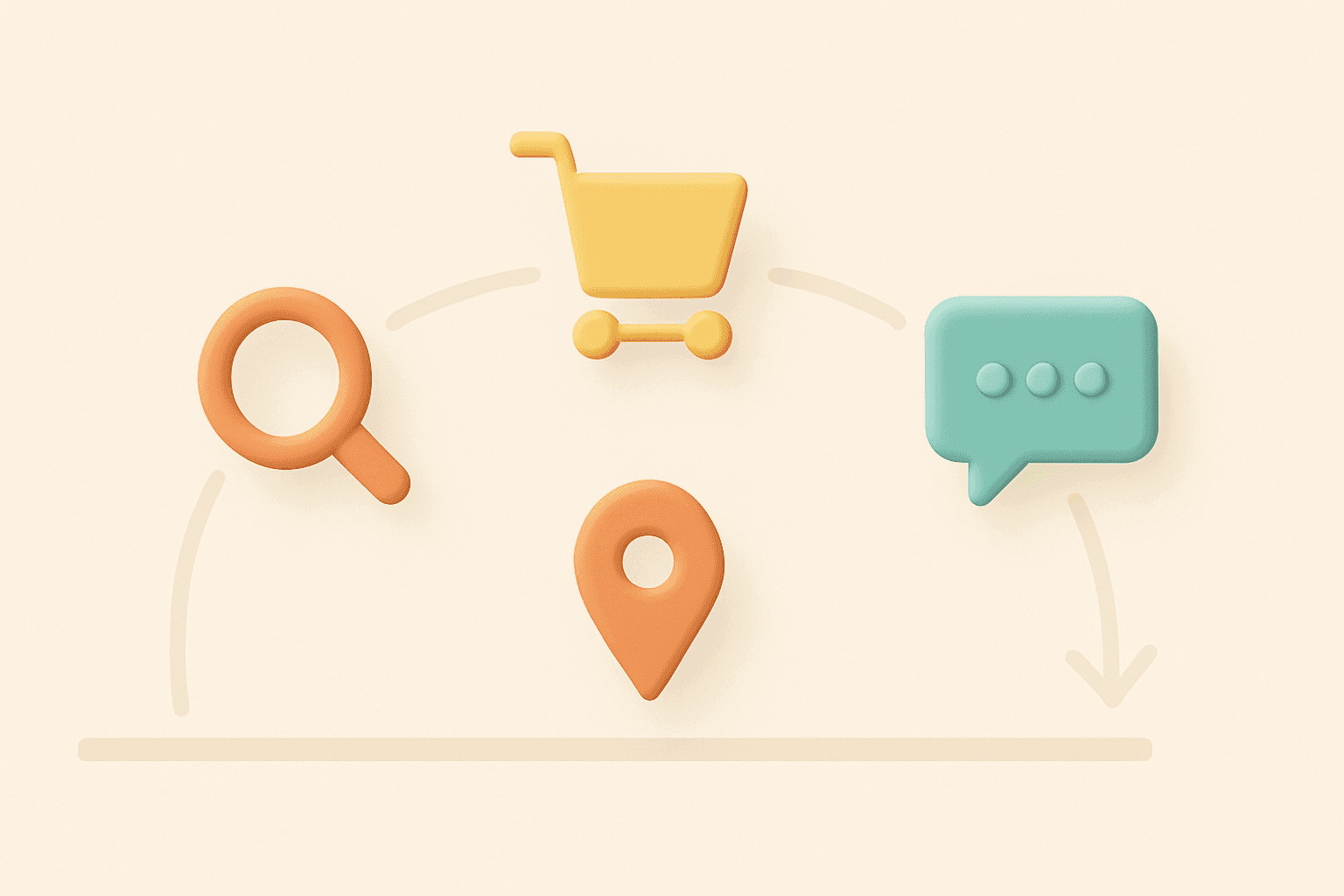The Complete Enterprise Guide to Omnichannel Retail in 2025
For enterprise and mid-market retailers, omnichannel retailing is the difference between managing channels and orchestrating a unified brand experience.
At its core, omnichannel retailing integrates every customer touchpoint into a single system that shares data, inventory, and interactions in real time. This isn’t just about convenience; it’s about competitive advantage.
Whether you're replatforming, expanding globally, or aiming to improve customer retention, understanding what makes a retailer truly omnichannel is now mission-critical. In this guide, we’ll break down the models, tools, and decisions shaping omnichannel success—grounded in real-world use cases, enterprise challenges, and strategic impact.
What is Omnichannel Retailing?
Omnichannel retailing is the modern model of enterprise retail commerce—where stores, websites, mobile apps, social platforms, and marketplaces operate as one connected system, orchestrating every sale, fulfillment, and customer interaction through a unified experience.
A truly omnichannel retailer gets three things right:
-
Integrated Channels – Every touchpoint is connected in real time (e.g., add-to-cart on mobile, complete in-store), allowing the experience to flow without repetition.
-
Unified Customer Data – Profiles, preferences, and history sync across systems, so a customer’s journey can be personalized and continued on any platform.
-
Cross-Channel Continuity – The journey doesn’t restart with each channel—progress, offers, and service stay consistent throughout.
Understanding what omnichannel retail really means goes beyond presence—it’s about performance across connected channels. For example, a customer might discover a product on Instagram, check its availability via a mobile app, schedule in-store pickup, and receive personalized post-purchase follow-up—all without friction or starting over.
This level of coordination requires a robust backend. Enterprise omnichannel strategies typically integrate:
-
POS systems for linking in-store transactions to digital accounts
-
OMS platforms to sync inventory across locations and fulfillment methods
-
CRM and CDP systems to centralize customer profiles and engagement data
Retailers like Sephora and Target are leading examples. Sephora’s Beauty Insider program connects in-app behavior, loyalty data, and store purchases. Target’s app syncs wishlists, location-specific inventory, and self-checkout—all within a single, continuous experience.
Here’s how omnichannel retail compares to traditional multichannel approaches across key dimensions:
| Aspect | Multichannel | Omnichannel |
|---|---|---|
| Channel Integration | Siloed | Unified |
| Inventory View | Per Channel | Real-time, centralized |
| Customer Profile | Fragmented | Consistent |
| Example | Separate ecom and store checkout | Cart starts online, completes in-store |
Why Omnichannel Retail Works: Revenue, Supply Chain, and Loyalty Gains for Enterprise Retailers
Enterprise retailers with integrated omnichannel strategies are seeing measurable gains—faster inventory turns, higher revenue per customer, and stronger loyalty signals. Below, we break down the impact by business function.
Revenue and Market Share Impact
A 2024 Forrester Retail Benchmark Report found that enterprise retailers with advanced omnichannel strategies grew revenue 2.8x faster year-over-year compared to their single-channel peers. These leaders also reported 12% higher profit margins, driven by improved cross-channel orchestration, optimized fulfillment, and higher average order values (AOV). For enterprise brands, the financial upside of a connected omnichannel model extends beyond sales—it enables market share gains across both digital and physical retail environments.
Supply Chain and Fulfillment Efficiency
Omnichannel fulfillment systems are delivering measurable operational gains for enterprise retailers. According to Zebra’s 2024 Global Shopper Study, 73% of retailers improved inventory accuracy by over 25% after adopting fulfillment models like ship-from-store and BOPIS. These strategies are now deployed by 83% of large retailers, up from 67% in 2022. For omnichannel leaders, these models reduce missed sales, lower holding costs, and improve delivery speed—offering faster ROI than many front-end investments.
Customer Experience and Loyalty Impact
Omnichannel customers aren’t just more satisfied—they’re more valuable. 83% of shoppers now expect flexible fulfillment and meeting that expectation leads to higher retention. According to 2024 data, retailers with advanced omnichannel programs see an 80% lift in incremental store visits—creating more opportunities for upsell and loyalty conversion. Unified customer profiles enable personalized offers that carry across email, app, and in-store interactions—building long-term customer value.
For enterprise leaders, the first step isn’t chasing new channels—it’s unifying what you already have. Centralizing inventory visibility and customer data lays the foundation for scalable personalization, faster fulfillment, and measurable revenue growth. These aren’t just technical upgrades—they’re strategic levers for sustained competitive advantage.
Omnichannel Retail Tech Stack: Core systems for Real-time, Cross-Channel Execution
For omnichannel retail to deliver on its promise—personalized experiences, real-time fulfillment, and seamless cross-channel transitions—the technology foundation must be tightly orchestrated. Below is a breakdown of the critical components every enterprise retailer needs to build a resilient, high-performance omnichannel stack.
Unified Customer Data Platform (CDP)
A modern omnichannel retail stack starts with a Customer Data Platform that aggregates real-time behavioral, transactional, and engagement data across all touchpoints—ecommerce sites, store systems, mobile apps, and social commerce.
At minimum, a retail CDP must support:
-
Real-time data ingestion from digital campaigns, POS, loyalty programs, and service platforms
-
Identity resolution to unify fragmented records across channels
-
Activation hooks into CRM, marketing automation, and personalization engines
CDPs are essential to powering omnichannel tactics like abandoned cart recovery triggered by in-store purchases or in-app behavior influencing email campaigns.
When selecting a platform, prioritize real-time processing, privacy compliance, and integration readiness with core retail systems.
Inventory and Order Management Systems (OMS)
In an enterprise omnichannel retail operation, your Order Management System is the operational backbone—orchestrating inventory, routing, and fulfillment decisions across every sales and service channel.
A modern OMS must go beyond order capture and support real-time responsiveness at scale.
Core Capabilities Every Omnichannel OMS Must Deliver:
-
Real-time inventory sync across warehouses, storefronts, and marketplaces
-
Dynamic order routing based on inventory availability, shipping SLAs, and location-based cost optimization
-
Returns and reverse logistics workflows that span online, in-store, and partner drop points
-
Native or API-ready integration with Warehouse Management Systems (WMS), POS, ecommerce platforms, and ERP
💡Pro Tip: Brands operating more than 3 physical hubs or with regional fulfillment SLAs should consider adopting an OMS designed for multi-node orchestration.
Cross-Channel Analytics and Reporting
Analytics isn’t just post-mortem reporting—it’s the engine behind real-time decisions, channel orchestration, and customer journey optimization.
To be effective at scale, your analytics layer must connect data across ecommerce, in-store, mobile, and fulfillment systems—and turn it into actionable intelligence.
Capabilities to Prioritize in Your Analytics Stack:
-
Customer journey analytics: Track behavior across touchpoints—from ad impression to store visit to repeat purchase
-
Real-time operational dashboards: Surface live KPIs for store teams, inventory planners, and digital marketers
-
Predictive forecasting models: Optimize stock levels and staffing based on past and projected demand
-
Cross-channel attribution modeling: Accurately assess the impact of marketing and merchandising across email, SMS, paid media, and in-store displays. Attribution modeling across channels
💡 Decision Signal: If your ecommerce and store data are still reported separately, it's time to unify your analytics model around the entire customer lifecycle—not just isolated events.
System Integration Considerations
Integration is the most underestimated barrier to omnichannel execution—and often the most expensive to fix post-launch.
In enterprise retail environments, success hinges on aligning real-time data flows across systems that were never designed to talk to each other. Think POS, ecommerce, ERP, WMS, CRM, and CDP—all moving inventory, orders, and customer data in parallel.
Key Integration Requirements:
-
API-first architecture for all platforms to enable modular, future-proof connectivity
-
Real-time data sync between POS, ecommerce, and fulfillment for inventory accuracy and customer visibility
-
Middleware or integration layer to normalize data across vendors and prevent hardcoded dependencies
-
Scalable infrastructure that supports peak load orchestration during events like flash sales or new collection drops
Integration Pitfall: Many retailers still maintain separate data schemas across ecommerce and in-store systems—leading to inconsistent pricing, loyalty mismatches, and delayed fulfillment.
Fix: Implement a unified data model with real-time sync logic built into OMS and CDP layers. Choose platforms with proven enterprise retail integrations—especially for POS and ERP.
👉 Relevant read: Top Enterprise Omnichannel Commerce Platforms Compared — a breakdown of Shopify Plus, Salesforce Commerce Cloud, and more.
Why Most Omnichannel Retail Strategies Fail — And What High-Performing Brands Do Differently
1. System Misalignment: POS, OMS, and eCommerce Don’t Speak the Same Language
For many retailers, the most visible symptom of failure is broken inventory logic: online says “in stock,” store says “not available,” and fulfillment says “delayed.” This happens when POS, OMS, and eCommerce platforms operate on different data structures and sync intervals.
📉 Impact: Misaligned systems result in overselling, missed SLAs, and CX breakdowns—contributing to up to 26% of avoidable refunds (Zebra Global Retail Report, 2024).
What High Performers Do: Implement a real-time sync layer that standardizes data formats and transaction logic across POS, OMS, and eCom systems. Use event-based APIs or middleware (like MuleSoft or Celigo) to push changes instantly and detect lags. Monitor sync health like you’d monitor conversion rates—because they’re directly linked.
2. No Central Owner = No Accountability
Omnichannel doesn’t fail because the strategy is flawed. It fails because nobody owns execution across the full stack. Marketing owns CX, IT owns infrastructure, Ops owns fulfillment—and no one owns the full journey.
💸 Impact: Fragmented ownership causes delays, overlapping vendor contracts, and inconsistent roadmaps that slow time to value.
What High Performers Do: Set up an Omnichannel Taskforce or Center of Excellence (CoE) with authority, not just visibility. This cross-functional team should be measured against shared KPIs like time-to-fulfill, return reasons, and omnichannel NPS. Most importantly, give them budget and backlog control.
3. Complexity Before Readiness
Enterprise teams often rush into personalization, ML-driven demand forecasting, or microservice architecture before fixing broken basics—like warehouse data not syncing with product availability online.
🔄Impact: AI can't compensate for inaccurate inputs. Advanced tools compound failure if foundational ops aren't stabilized.
What High Performers Do: Adopt a crawl → walk → run roadmap tied to operational maturity. Start with inventory accuracy (>98%), then OMS logic for order splitting, and only then move into personalization. Don’t roll out headless commerce until inventory and fulfillment APIs are stable across all nodes.
Future of Omnichannel Retail: Trends and Technologies
AI-Driven Personalization and Predictive Analytics
Artificial intelligence (AI) and machine learning (ML) are now central to enhancing retail personalization and operational efficiency. Retailers are leveraging AI to deliver tailored customer experiences, optimize inventory management, and streamline operations. For instance, predictive analytics enables businesses to forecast demand accurately, reducing overstock and stockouts.
Immersive Technologies: Augmented and Virtual Reality
Brands are utilizing AR for virtual try-ons and interactive product displays, enhancing customer engagement and satisfaction. The AR and VR market is projected to reach $96.32 billion by 2029, indicating significant growth and adoption across industries, including retail.
Blockchain for Supply Chain Transparency
Blockchain technology is enhancing supply chain transparency and traceability. By providing an immutable ledger of transactions, blockchain allows retailers to track products from origin to shelf, ensuring authenticity and reducing fraud. This increased visibility fosters consumer trust and supports ethical sourcing practices.
Composable Commerce for Agile Retail Architecture
Composable commerce is gaining traction as retailers seek flexible and modular systems. By adopting a composable approach, businesses can integrate best-of-breed solutions, enabling rapid adaptation to market changes and customer demands. This architecture supports scalability and innovation, essential for maintaining competitiveness in a dynamic retail environment.
Planning your omnichannel roadmap?
Get a 1:1 consultation with our retail systems experts. We’ll walk through your current stack, channel strategy, and customer journey gaps—and map a solution that scales.
👉 [Book your omnichannel strategy session – drop a line at hello@coderapper.com]






